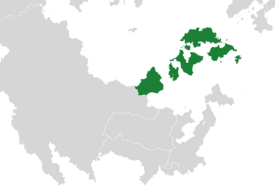Pulau Keramat
The United Confederacy of Pulau Keramat Pulau Keramat Tanah Suci เกาะศักดิ์สิทธิ์ ເກາະສັກສິດ Moutere Tapu | |
|---|---|
|
Flag | |
| Motto: Untuk Persatuan Kita ("เพื่อความสามัคคีของเรา", "For Our Unity") | |
| Anthem: ' ("Matahari Terbit Kepulauan","พระอาทิตย์ขึ้นของหมู่เกาะ","Sunrise of the Archipelago") | |
 Territorial map of united Pulau Keramat | |
| Capital | Kopiona Poi |
| Largest | Tau Harimua |
| Official languages | Za'gree, Zahrani, Raji, Tuganani, Ahlranese |
| Recognised regional languages | Tsurushimese, Ommere, Maori |
| Ethnic groups | 20% Zahran 12.5% Za'Gree 12.5% Raji 12% Ahlran 10% Tuganani 5% Tsurushiman 2.7% Maori 25.3% Other |
| Demonym(s) | Pulaui |
| Government | Confederated Oligarchical Constitutional Republic |
| Maurani Rahmkha | |
| Asmoro Mar-Ko-Jo | |
| Dwi Cahyo Metharom | |
| Anunak Leekpai | |
| Pertiwi Bambang Pangabbean | |
| Mutenge Kunokoa | |
| Unification | |
• Pulau Keramat Declaration | 17 July 1932 |
• The Dewan Emas Agreement | 26 March 1953 |
• The Kirimoru Clause (Acceptance of Sinavia) | 3 August 1960 |
| Area | |
• | 1,289,056 sq mi (3,338,640 km2) |
| Population | |
• 2017 estimate | 83,452,600 |
• 2014 census | 80,231,834 |
| GDP (PPP) | 2017 estimate |
• Total | $1.480,31 billion |
• Per capita | $17,738.83 |
| GDP (nominal) | estimate |
• Total | $1.658,39. billion |
• Per capita | $19,872.49 |
| Gini | 44.1 medium |
| HDI | .886 high Error: Invalid HDI value |
| Currency | Rigganit (PKR) |
| Date format | dd.mm.yyyy |
| Driving side | left |
| Calling code | +63 |
| ISO 3166 code | PK |
| Internet TLD | .pk |
Pulau Keramat is a sovereign nation within Malaio, bordering Kalakora, Onekawa-Nukanoa Iskali, and Socoasen to the South, and the Vespanian Sea to the North, sharing a maritime border with Benaajab, Sampeng, and The Daitoa Republic. It is the Xth largest nation in Ajax, and the Xth largest nation in Malaio. The current day Archipelago is the birthplace of the N'nhivara faith.
Pulau Keramat identifies as a confederated oligarchical republic, with each of the respective six nations that make up the confederacy separating power and executive decision making to both their own leaders, and the overarching Dewan Emas, a council that is elected through both technocratic exams inspired by the Daitoa republic, and standard tiered voting practice, with re-election occuring every five years, at staggered results.
Pulau Keramat is one of the more influential states within its region, holding enormous economic importance to the Ozeros, Malaio, and southern Ochran due it's important location at the mouth of the Ozeros Sea, its development in re-exporting goods to various political identities, and serving as a point of collaboration for socialist and communist markets to exchange into capitalist markets, facilitating exchanges and ensuring important in such divisions. The current state identifies itself as holding a 'Socialist-Oriented Market Economy', and thus finds steady and stable interactions with various states regardless of their own systems of governance. This is facilitated primarily through semi-state-owned organizations such as the Vespanian Exchange Institute. The confederacy itself has enacted policies and such 'emas' councils with responsibility over healthcare, infrastructure, and environmental policy, in contrast to each of the individual member states establishing separate judicial, educational, and social welfare policies; albeit many of these follow in similar trends to one another.
Pulau Keramat is a founding member of the Association of Malaio Ozeros Nations, as well as the Four Rising Nations Summit, and has happily embraced membership with the Harmonious Covenant of Ochran, with attempts to serve as a facet of communication between the various regions in both political standard, economic relay, and socio-cultural exchange. These connections have resulted in several harbor cities in Pulau Keramat boasting enormous international populations and facets of cultural exchange.
Pulau Keramat has earned an international reputation for being a home to an extensively diverse community, with several official languages, and predominant faiths that derive from indigenous ethnic groups, resulting in the Pulaui identity being a difficult moniker to place in any one facet. The extent of the Atthuna Script serving as a parent to many of the languages.
History
Politics
Culture
Language
Religion
Ethnicity
Largest Cities
| Rank | Nation | Pop. | Rank | Nation | Pop. | ||||
|---|---|---|---|---|---|---|---|---|---|
 Tau Harimua  Kopiona Poi City |
1 | Tau Harimua | Birhanu | 9,997,264 | 11 | Londowiti | Sina'Uia | 731,645 |  Nhivaran  Akajara |
| 2 | Kopiona Poi City | Kopiona Poi | 9,922,491 | 12 | Chum Nuea | Orang Uslia | 601,651 | ||
| 3 | Nhivaran | Orang Uslia | 5,762,842 | 13 | Bacolod | The Solustheris | 552,983 | ||
| 4 | Akajara | The Solustheris | 3,232,408 | 14 | Pasuruin Poi | Nahkarain | 503,844 | ||
| 5 | N'nhiva Uejarang | Nahkarain | 1,802,000 | 15 | Sekang | Birhanu | 490,509 | ||
| 6 | Lata-Na-Ai Omie | Sina'Uia | 1,461,536 | 16 | Bang Si Sriram | Orang Uslia | 453,450 | ||
| 7 | Tanjung Huiriamg | Nahkarain | 1,201,332 | 17 | Puahng Jerehannak | Birhanu | 372,324 | ||
| 8 | Yungumoologa | Sina'Uia | 989,003 | 18 | Milenena | The Solustheris | 323,429 | ||
| 9 | N'nhiva Urinang | Birhanu | 833,551 | 19 | Kagu'aiapat | Sina'Uia | 302,201 | ||
| 10 | Burinha Lipa | Kopiona Poi | 823,718 | 20 | Ado'umo | Sina'Uia | 278,056 | ||
